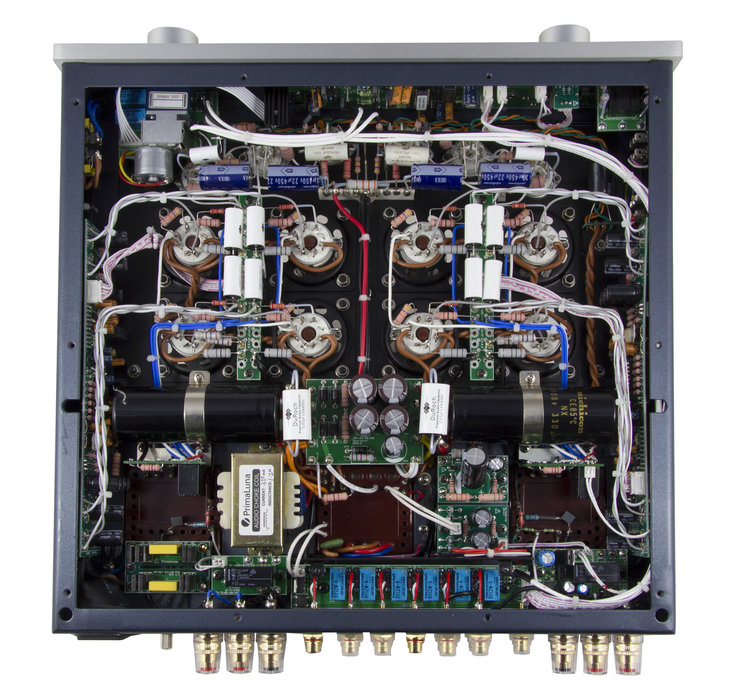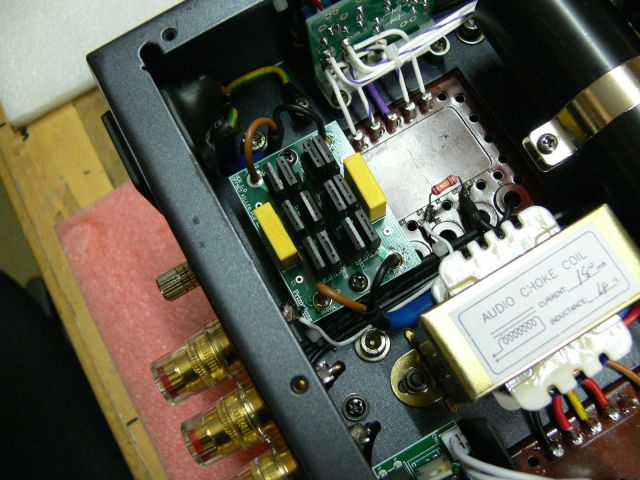I think it is a set of antiparalell diodes in series with the transformer load, with a snubber cap to reduce the ringing.
the 0.7V threshold means that it can tolerate +/- 0.7V dc offset.
if more diodes are placed in series it can tolerate more offset. at the cost of some dissipation.
the 0.7V threshold means that it can tolerate +/- 0.7V dc offset.
if more diodes are placed in series it can tolerate more offset. at the cost of some dissipation.
In the beginning, after reading this “Our engineers designed the AC Offset Killer to lower transformer noise to a place no other manufacturer dreams of going, regardless of how bad your electricity is. The result? Sense of space. Texture. The resonance of an acoustic guitar or violin string that seems to trail on forever. The AC Offset Killer will amaze you. “ I thought it’s just a marketing gimmick.
As far as I understand, the circuir was originally designed but the parent company Ah! Tube who manufactured a power outlet called Ah! AC Offset Killer “AC Conditioner which improves sound and "kills" mechanical transformer hum!”
If it’s such a simple and effective circuit why not everyone else is using it?
Can we build it and test its claims? It costs what? $5-10?
As far as I understand, the circuir was originally designed but the parent company Ah! Tube who manufactured a power outlet called Ah! AC Offset Killer “AC Conditioner which improves sound and "kills" mechanical transformer hum!”
If it’s such a simple and effective circuit why not everyone else is using it?
Can we build it and test its claims? It costs what? $5-10?
Last edited:
In the beginning, after reading this “Our engineers designed the AC Offset Killer to lower transformer noise to a place no other manufacturer dreams of going, regardless of how bad your electricity is. The result? Sense of space. Texture. The resonance of an acoustic guitar or violin string that seems to trail on forever. The AC Offset Killer will amaze you. “ I thought it’s just a marketing gimmick.
Good lord! That's some pretty high end marketing drivel there.
The circuit in the picture appears to be a DC block, and not a very well designed one at that. Here's what Rod Elliott recommends:
An externally hosted image should be here but it was not working when we last tested it.
You can read his writeup here: Mains DC and Transformers
DC on the mains can cause some mains transformers to hum from mechanical vibration. The DC blocker eliminates this hum. It doesn't impact the signal amplified by the amp in any way, it is purely to address any mechanical hum/buzzing of the transformer.
Tom
Last edited:
Interesting, I wonder why they are claiming it improves sound?!
It looks like they put this circuit only in their premium products (over $3k).
If it's such a simple, cheap and effective circuit why don't they put in all their products?
If Tom & Rod are right then Primaluna is shameless.

It looks like they put this circuit only in their premium products (over $3k).
If it's such a simple, cheap and effective circuit why don't they put in all their products?
If Tom & Rod are right then Primaluna is shameless.

Last edited:
I had a terribly humming NAP 250 DR (as in very audible @ 7m). When measured (with primitive tools), I measured slightly more than 500mV offset. I've built the schematic as shown by Tom here above and the humming went away (and while I was at it, I put a 1µF cap in parrallel as well. Not sure what difference that made).
This brought peace and quite in the music. Difficult to say whether this is the result of what in the end comes out of the speakers, or because the absence of the hum.
In the meantime the nap is replaced with NC400's, and if I put these after this circuit, they'll cause my preamp to hum...
This brought peace and quite in the music. Difficult to say whether this is the result of what in the end comes out of the speakers, or because the absence of the hum.
In the meantime the nap is replaced with NC400's, and if I put these after this circuit, they'll cause my preamp to hum...
This, as the Rod Elliott article elegantly describes, is what is wrong with such cheap versions: the AC current is (should be!)a passed entirely by the capacitance. The only purpose of the diodes is only to limit the maximum reverese DC voltage offset the large electrolytic capacitors are exposed to. The idea that two diodes is better than one (for '1.4v dc protection') is completely false.ech line has 2 series 2 antiparell diodes, the rod elliot circuit in each line, except 0.1uf instead of 2200uF to save money.more a 10$ circuit
In any case, so is calling the problem 'DC' ; it is not; it is low-harmonic noise, principally 2nd HD. Build a filter to try to measure 'DC' on the mains (requires a little finesse*, and since here I'm on 240VAC I'm not posting it in interests of ..general safety/not breaching the DIYA 'no mains-direct connection' discussion reqt: it could kill) - but I found there's little but c. <10mV at worst.
*sticking your cheap DVM probes into the wall socket and selecting 'dc' measurement range is no measure at all.
Last edited:
ech line has 2 series 2 antiparell diodes, the rod elliot circuit in each line, except 0.1uf instead of 2200uF to save money.more a 10$ circuit
Especially after looking at the 2nd photo, it doesn't look like Elliot's circuit. Also, what's the purpose of the whole in the middle of the circuit board? The brown and blue wire come from the power plug or from the power button top left?
More info on their blog, they seem pretty pretty proud of this little circuit:

Welcome to the Machine… PrimaLuna DiaLogue Premium Integrated Amplifier 2012 (part 2) | PrimaLuna's Blog
===
"Functionality:
The filter was designed by us many years ago to eliminate mains pollution, especially DC components coming from the mains. A small amount of DC on the mains, occurs a lot of hum in Toroidal transformers of High End Audio equipment. Specially in case of power amplifiers which use larger toroid transformers. The bigger the amp (and the transformer) the worse the hum might become.
(PS For your information and better understanding: The first time we used this filter was when we were dealing with a very annoying humming integrated amplifier. We also offered the board to be built in other products suffering from humming toroid transformers. Most recently we built a higher powered version of this circuit to make some top-of-the-bill humming mono amplifiers dead silent and best sounding).
Why add it to a product that is already known to be dead silent in every possible way? Just because we know AC is getting more polluted every day. So what we do now, might benefit you in the future: our desire to give you a “best level possible” sound quality, reliability, value. Now and in the years to come.
DC Killer:
The DC Killer is designed around twelve fast switching diodes with soft recovery time, like the STTH8L06FP. This diode can handle 10Amps, with a recovery time of 105ns! They are also hermetically sealed in a plastic TO220FP case. Next to that the diodes are filtered with good quality capacitors. The full circuit is built on a dedicate pc board positioned at the AC entrée for maximum effect."
Last edited:
Interesting, I wonder why they are claiming it improves sound?!
Because it sells amps. "Our amp is special! It has our amazing patented WizzBang2000™ in it. You should buy our amp." It's a pretty common snake oil sales technique.
Ok, so the circuit costs aprox $20 in parts at Mouser.
Are these DC blocks in series or in parallel?
Shouldn't be that much. The caps won't see more than 2*Vd = 1.4 V, so a 4 V or 6.3 V type is plenty. The diode bridge needs to be able to handle the primary current. Something like a GBPC2510 is overkill, but would make for a nice unit that you can bolt to the chassis.
It looks like Primaluna is using a DC blocking circuit in series with both the live and the neutral mains wire. That's misguided at best. You only need one DC block. They also use 0.1 uF, which is rather small. Basically, they're adding resistance in series with the transformer primary. That may change the sound of the amp, but I highly doubt it changes it for the better.
Tom
This last board is not a Krell product. It has been designed as an "upgrade board" for Krell by AH! and in the middle there is also a Schaffner filter - a bad, bad idea. The board also provides overvoltage protection.
Could anyone enlighten me how is dc blocking provided without caps?
Could anyone enlighten me how is dc blocking provided without caps?
Interesting, I wonder why they are claiming it improves sound?!
Anyone who has built a dc blocker and is not entirely deaf knows that it significantly changes the sound. My experience has been limited to SS amps where the bass using a blocker suffered to a degree, but the blocking elements were capacitors which can significantly colour the sound. A capacitor free dc blocker, as the one from Prima Luna, may not have this problem.
....
In any case, so is calling the problem 'DC' ; it is not; it is low-harmonic noise, principally 2nd HD. Build a filter to try to measure 'DC' on the mains (requires a little finesse*, and since here I'm on 240VAC I'm not posting it in interests of ..general safety/not breaching the DIYA 'no mains-direct connection' discussion reqt: it could kill) - but I found there's little but c. <10mV at worst.
If you have less than 10mv offset, you're probably not interested in a DC blocker. It won't do much. I have more around 4-500mV (with a distinct 24h and 7d period). A DC blocker will not block a 2nd harmonic (neither do I believe 2nd harmonics are problematic, they look uggly on scope, but should be well filtered by your power supply).
I had a terribly humming NAP 250 DR (as in very audible @ 7m). When measured (with primitive tools), I measured slightly more than 500mV offset. I've built the schematic as shown by Tom here above and the humming went away (and while I was at it, I put a 1µF cap in parrallel as well. Not sure what difference that made).
This brought peace and quite in the music. Difficult to say whether this is the result of what in the end comes out of the speakers, or because the absence of the hum.
I can see one path where mechanical hum can make it into the signal path in a tube amp: Microphonics. Some tubes are pretty microphonic, i.e. they will pick up mechanical vibration and translate it to a change in current or voltage. If the hum from the transformer is enough to cause vibrations in the chassis, you could end up with IMD components at the mains frequency and those can certainly be audible. I generally experience those IMD products as "fuzz" or "haze" or "lacking clarity".
Anyone who has built a dc blocker and is not entirely deaf knows that it significantly changes the sound.
With bombastic language like that, would you happen to have a link to the research that backs this up? Preferably a controlled study with a significant sample size (N ≥ 30).
Tom
- Home
- Amplifiers
- Power Supplies
- Primaluna's AC Offset Killer

